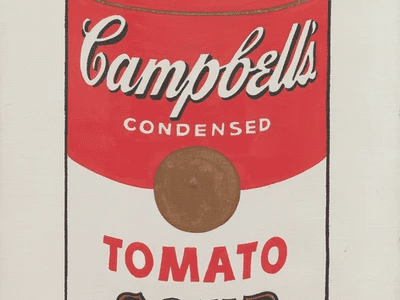Pop Art Simplified
Pop art is an art trend that began in the mid-to late-1950s in the United Kingdom and the United States. By using imagery from popular and mass cultures, such as advertising, comic comics, and everyday mass-produced goods, the movement posed a challenge to fine art traditions.
The Pop art movement intended to merge the lines between “high” art and “low” culture by painting or sculpting images of popular culture products and celebrities. One of the most significant elements of Pop art is the idea that there is no hierarchy of culture and that art may take from any source.
Summary of Pop Art
Revolutionizing the art world in the 1950s, artists from New York, pioneered pop art by drawing on common iconography and becoming part of an international movement. Pop’s return of recognisable iconography (taken from mass media and popular culture) was a dramatic turn in the path of modernism following the popularity of the Abstract Expressionists. Pop artists praised mundane things and people from everyday life, attempting to elevate popular culture to the level of great art. The subject matter shifted away from conventional “high art” subjects like morality, mythology, and classic history.
- The Pop art movement intended to blur the lines between “high” art and “low” culture by painting or sculpting images of popular culture products and celebrities. One of the most significant elements of Pop art is the idea that there is no hierarchy of culture and that art may take from any source.
- It may be claimed that Abstract Expressionists were looking for signs of pain in the soul, whereas Pop artists were looking for evidence of the same pain in the mediated world of advertising, cartoons, and popular imagery in general. Pop artists, on the other hand, were likely the first to grasp that there is no direct access to anything, be it the soul, the natural world, or the constructed environment. Everything is interconnected, according to pop artists, thus they tried to make those links real in their work.
- Pop art comprises a vast range of work with a wide range of attitudes and postures, although most of it is emotionally detached. Pop art is often “hot” ambivalence, in contrast to the “coolly” expression of gestural abstraction that preceded it. Much has been said about whether this indicates acceptance of the popular world or a horrified withdrawal.
- The post-World War II manufacturing and media boom seemed to be embraced by pop musicians. Some critics have interpreted Pop art’s imagery as an enthusiastic endorsement of the capitalist market and the goods it circulated, while others have seen a cultural critique in the Pop artists’ elevation of the everyday to high art: tying the commodity status of the goods represented to the status of the art object itself, emphasising art’s place as, at its most basic, a commodity.
- Andy Warhol was a highly successful magazine illustrator and graphic designer; Ed Ruscha was also a graphic designer, and James Rosenquist began his career as a billboard painter. Their experience in the commercial art industry taught them the visual lexicon of mass culture as well as the strategies for blending high art and popular culture effectively.
Why is it Called Pop Art?
It was dubbed Pop Art because of its intended mass appeal and involvement with popular culture. Pop painters aimed for simplicity in their work, frequently painting with large swathes of primary colours directly from the can or tube.
Everything About Pop Art
The Beginnings
The beginnings of pop art in North America differed from those in the United Kingdom. Pop art was a response by artists in the United States, and it signalled a return to hard-edged composition and realistic painting. They employed impersonal, everyday realism, sarcasm, and satire to “defuse” abstract expressionism’s personal symbolism and “painterly looseness” Some works by Larry Rivers, Alex Katz, and Man Ray in the United States foreshadowed pop art.
The roots of pop art in post-war Britain, on the other hand, were more scholarly, notwithstanding the use of sarcasm and parody. Britain focused on American pop culture’s dynamic and contradictory images as strong, manipulative symbolic devices that were changing whole patterns of existence while also increasing a society’s prosperity. When observed from afar, early pop art in Britain was a matter of ideas inspired by American popular culture. Pop art, meanwhile, was both a continuation and a rejection of Dadaism.
While pop art and Dadaism both dealt with similar topics, pop art substituted the Dada movement’s destructive, sarcastic, and anarchic tendencies with a detached embrace of mass culture’s artefacts. Pablo Picasso, Marcel Duchamp, and Kurt Schwitters are some of the European artists whose work is seen as a precursor to pop art.
Concepts In Pop Art
Following the completion of the shift from the Neo-Dada artists’ found-object creations to the Pop movement, there was significant interest among artists in incorporating popular culture into their work. Although the Independent Group in London was the first to adopt the term “pop” in relation to art, American artists quickly followed suit and began incorporating popular culture into their work. Although the artists’ approaches differ greatly, they all have one thing in common: they all use popular culture images as their primary theme.
Andy Warhol in Pop Art
Andy Warhol is most known for his vibrantly coloured portraits of celebrities, although he has worked on a wide range of subjects throughout his career. The common thread that runs across all of the topics is that they were all inspired by mass consumer culture. Objects like Coca-Cola bottles and Campbell’s soup cans are endlessly duplicated in his early pieces, as if the gallery wall were a supermarket shelf. To simplify the large-scale duplication of pop graphics, Warhol switched from hand painting to screenprinting. Warhol’s aversion to mechanical duplication shattered ideas of creative originality and brilliance. However, he accepted the monetization of art, demonstrating that paintings, like Campbell’s soup cans, had monetary value and can be purchased and sold like consumer items. In images like Marilyn Diptych, he further connected the mass-produced status of commercial products with that of celebrities.
After Pop Art
Pop art undoubtedly influenced artists throughout the 1980s, with artists like as Andy Warhol retaining a larger-than-life presence in the New York art community. During the 1970s, pop went out of popularity as the art world switched its attention away from art objects and more towards installations, performances, and other less physical art forms. However, with the resurrection of painting in the late 1970s and early 1980s, the art object resumed popularity, and popular culture gave subject matter that was simple to recognise and grasp for viewers. Jeff Koons, a key participant in the Neo-Pop movement, pushed the frontiers of fine art farther by appropriating pop culture icons like Michael Jackson and mass-produced products like Hoover vacuum cleaners. Takashi Murakami’s work has been considered as a more modern example of Neo-Pop in Japan, due to his Superflat style’s usage of popular anime iconography and his lucrative collaborations with fashion companies such as Louis Vuitton. Such artists continue to blur the lines between high and low art forms, while also rethinking the function of art as a commodity.
Key Art in Pop Art

Campbell’s Soup I
By Andy Warhol
Like the abstractionists, Warhol’s famed series of Campbell’s Soup Cans paintings were never supposed to be appreciated for their form or compositional approach. Warhol’s co-opting of generally familiar iconography, such as a Campbell’s soup can, Mickey Mouse, or the face of Marilyn Monroe, and showing it as a mass-produced commodity, but inside a high art framework, was what made these works notable. In this way, Warhol wasn’t only accentuating popular images; he was also commenting on how people have come to regard these things in modern times: as commodities to be bought and sold, easily identified as such.
A Bigger Splash
By David Hockney

This enormous work, which measures around 94 by 94 inches, was inspired by an image of a swimming pool that Hockney saw in a pool handbook. “I loved the idea of painting this thing that lasts for two seconds: it takes me two weeks to paint this event that lasts for two seconds,” Hockney said of the notion of a painting recapturing a fleeting moment caught in a photograph. The splash’s dynamic contrasts sharply with the house’s static and rigid geometry, as well as the pool edge, palm trees, and the vivid yellow diving board, which are all meticulously positioned in a grid around the splash.
Information Citations
En.wikipedia.org, https://en.wikipedia.org/.
Recommend0 recommendationsPublished in Art History, Art Movements




Responses